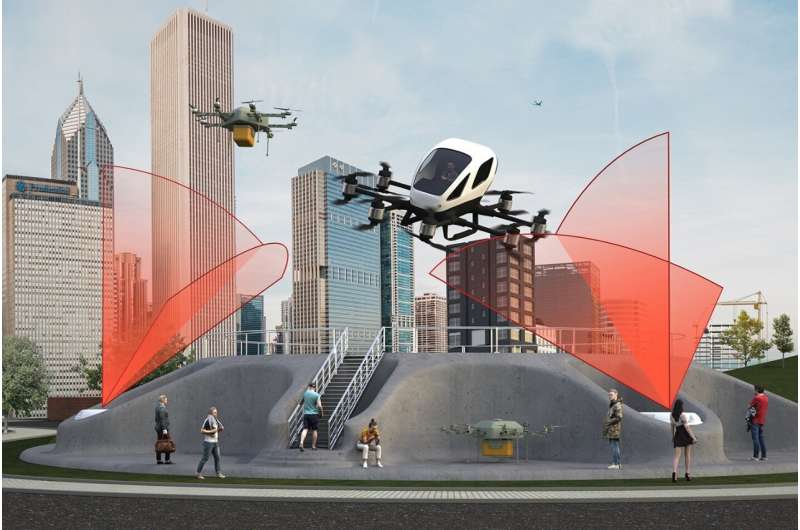
For the first time, visitors at the 2024 Olympic Games will be able to fly to venues using air taxis. Vertical takeoff aircraft such as drones, multirotors and air taxis will take off from and land on pads known as vertiports.
Researchers at the Fraunhofer Institute for High Frequency Physics and Radar Techniques FHR are developing an entirely digital sensor network, including a radar sensor, that in the future will be able to closely monitor air traffic at a vertiport and ensure safe flight operations. The system includes decentralized active and passive sensors with fully autonomous functionality, linking to each other and collectively sensing the port.
Drones and multirotors are already used in civil protection, by fire services and for bridge inspections. In the future, these unmanned aerial vehicles (UAVs) will be used for other tasks, too, such as in logistics for delivering packages. At the 2024 Olympic Games in Paris, the first passengers in Europe will be transported by air taxis.
Air travel companies are planning to equip Olympic venues with electrical vertical takeoff and landing systems, otherwise known as eVTOLs, to transport visitors from the airport to events. Initially, the drone systems will be piloted by a human—with one passenger per taxi. In the coming years, they should then be piloted autonomously, provided that society accepts this.
An important aspect of this concept is the safety of the vertiports used for launching and landing eVTOLs, which will be integrated into roofs, train stations, parking lots and other urban structures. Vertiports must meet the strictest safety requirements. Researchers at Fraunhofer FHR aim to tackle an important part of the safety of the new drone stops by equipping them with a modular, fully digital sensor network including a radar sensor. The network can be adapted to the size of each vertiport and uses both active and passive sensors.
Radar network uses active and passive sensors to self-regulate
"The nodes are fully digital, and each sensor in the network functions entirely autonomously. The sensors aren't coordinated by a central computer unit; they network themselves. They are able to independently localize and organize themselves. Based on the principle of edge computing, each sensor has its own computer unit and can detect the location of other sensors in the network," explains Oliver Biallawons, scientist and member of the interdisciplinary expertise group "Civil Drone Systems" at Fraunhofer FHR in Wachtberg.
The job of sending and receiving is shared between the individual sensors, which coordinate with each other. The decentralized active and passive sensors are installed on the ground and work together to sense the entire takeoff and landing pad as well as the airspace above it. The network decides which sensor to operate in active (sending and receiving) and passive (receiving only) mode as required.
The more sensors in the network, the greater the area that can be monitored. Even if a sensor or radar node is added or removed, the radar network can continue to function flawlessly.
The key to the network's autonomous organization and decentralized processing is the connection between the individual nodes via wireless communication channels integrated into the radar signal.
By integrating the network communication in the radar signal, the signal can be seamlessly integrated into future telecommunications infrastructures. This represents an important milestone on the path toward merging fully-fledged radar and telecommunications. "We are integrating the communication signal into the radar waves instead of using separate channels for radar and communication," said the engineer.
Citation: Developing a radar network for safe flight operations at vertiports (2024, February 1) retrieved 1 February 2024 from https://techxplore.com/news/2024-02-radar-network-safe-flight-vertiports.html
This document is subject to copyright. Apart from any fair dealing for the purpose of private study or research, no part may be reproduced without the written permission. The content is provided for information purposes only.
